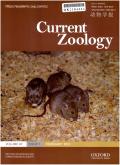生活史特征对远洋鱼类线粒体 DNA 替代率的影响超过代谢率的影响
IF 2
2区 生物学
Q2 ZOOLOGY
引用次数: 0
摘要
了解代谢率的分子相关性对于揭示动物进化的驱动机制至关重要。在这项研究中,我们调查了 139 种远洋鱼类的线粒体 DNA 特征与静息代谢率和最大代谢率以及生活史特征之间的关联。我们从各种渠道收集了鱼类的 MR 数据,并获得了 13 个线粒体蛋白编码基因的序列。我们计算了每个基因的整个核苷酸序列和四倍退化位点的绝对替代率,以及编码氨基酸序列。然后,我们利用系统发育比较法探讨了代谢率与线粒体 DNA 绝对替代率之间的关联。此外,我们还筛选了线粒体 DNA 中与代谢率相关的单核苷酸变异。研究结果表明,代谢率与综合序列和单个线粒体蛋白编码基因的任何替代率值之间都没有正相关,从而驳斥了代谢率假说。相反,最大体型和寿命与分子替换率呈负相关,这表明它们对鱼类线粒体基因的突变和固定都有影响。研究结果还揭示了 ATP6_169 碱基变异与静息代谢率和最大代谢率之间的显著相关性,确定了鲭科鱼类特有的 ATP6_169G,它导致 ATP6 蛋白的 pI 值极低。考虑到ATP6_169G的功能意义,鲭科鱼类的ATP6_169G可能与它们快速运动和高代谢需求的生活方式以及较慢的分子进化速度有关。本文章由计算机程序翻译,如有差异,请以英文原文为准。
Influence of life-history traits on mitochondrial DNA substitution rates exceeds that of metabolic rates in teleost fishes
Understanding the molecular relevance of metabolic rate is crucial for unveiling the mechanisms driving the evolution of animals. In this study, we investigated the association between mitochondrial DNA characteristics and both resting and maximal metabolic rates in conjunction with life-history traits among 139 species of teleost fish. We gathered fish MR data from various sources and procured sequences of 13 mitochondrial protein-encoding genes. We calculated the absolute substitution rate for entire nucleotide sequences and four-fold degenerate sites of each gene, along with encoding amino acid sequences. Using the phylogenetic comparative method, we then explored the associations between metabolic rate and mitochondrial DNA absolute substitution rate. Additionally, we screened metabolic rate-associated single nucleotide variants in mitochondrial DNA. The findings indicate no positive correlation between metabolic rates and any substitution rate values of both combined sequences and individual mitochondrial protein-coding genes, refuting the metabolic rate hypothesis. Instead, both maximum body size and longevity correlated negatively with molecular substitution rates, suggesting their influences on both mutation and fixation within mitochondrial genes in fish. Results also revealed significant correlations between base variation at ATP6_169 and both resting metabolic rate and maximum metabolic rate, identifying the unique ATP6_169G in Scombridae fish, which results in an extremely low pI value of the ATP6 protein. Considering its functional significance, the ATP6_169G in Scombridae fish might link to their lifestyle characterized by fast locomotion and high metabolic demands alongside a slower molecular evolutionary rate.
求助全文
通过发布文献求助,成功后即可免费获取论文全文。
去求助
来源期刊

Current Zoology
Agricultural and Biological Sciences-Animal Science and Zoology
CiteScore
3.20
自引率
9.10%
发文量
111
审稿时长
6 weeks
期刊介绍:
About the Journal
Current Zoology (formerly Acta Zoologica Sinica, founded in 1935) is an open access, bimonthly, peer-reviewed international journal of zoology. It publishes review articles and research papers in the fields of ecology, evolution and behaviour.
Current Zoology is sponsored by Institute of Zoology, Chinese Academy of Sciences, along with the China Zoological Society.
 求助内容:
求助内容: 应助结果提醒方式:
应助结果提醒方式:


